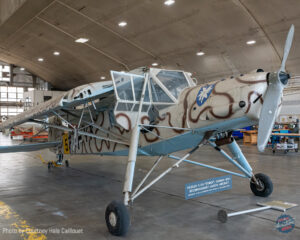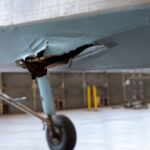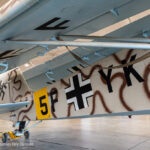By Courtney Hale Caillouet
At the close of 2023, the National Museum of the United States Air Force announced they would begin the restoration of their Fieseler Fi-156C-2 “Storch”; construction number 4389. Storch is German for the word stork; its gangly landing gear provided this nickname. Designed in the 1930s as a light observation and liaison aircraft, it was adopted by the Germans because of its excellent STOL (short takeoff/landing) characteristics. The type is well known for being used in the mountaintop rescue of Benito Mussolini, where other fixed-wing aircraft would certainly not have succeeded. It was produced well into the ’50s, with additional healthy sales to the civilian world.
The museum’s C-2 (previously incorrectly listed as a C-1) variant was built in 1940 and exported to Sweden in 1943, one of a vast number of countries adopting it for their arsenal. Sweden flew this aircraft type with the designation of S 14B, with this airframe given serial number 3808. By 1965, it was back in Germany in private hands. It was flown by top-scoring Luftwaffe pilot, Erich Hartmann, before making the move to the United States in 1973. This purchase was a partnership between Lt. Col. Perry A. Scheffler and Maj. Robert C. Van Ausdell of Santa Paula, California. Both men served as pilots in WWII and were later employed by TWA. It was given the FAA registration of N156SV and donated to the National Museum of the U.S. Air Force the following year. Just before this, the first man to fly supersonic, Brig. Gen. Chuck Yeager, also had a turn behind the controls.
Being suspended from the ceiling of the WWII gallery, it was removed in 2016 in preparation for B-17 Memphis Belle‘s display and public debut. Since then, it was placed in storage for eventual relocation, but needs a great deal of attention before this can take place.
The aircraft will be slowly disassembled to gauge the extent of restoration required, with the new fabric being an obvious point. Several holes are beginning to form around the fuselage, which appears to have been on the aircraft since its days in Europe. Despite the decay, the removal of the skin will be needed for a thorough accounting of any other preservation process required. The fuselage is of a tubular steel construction, with the wings being made largely of wood. These materials will also decline with age and a proper inspection will be administered. Stopping corrosion or breakdown will keep these artifacts on display for many more decades. Any missing or non-original components will need to be sourced and replaced, as the restoration team aims to keep the aircraft as close to manufacturing specs as possible.
When the aircraft was donated to the museum in 1974, it was painted to resemble an aircraft thought to be used by Erwin Rommel to observe his Afrika Korps during the campaign in North Africa. According to restoration and the research division, no evidence has yet been found that links Rommel himself to an aircraft with the markings of 5F+YK, believing this to be inaccurate. As it currently stands, nothing has been decided yet as to the end product. The team will determine the best way to repaint and display the Storch, fitting it into the WWII gallery’s storyline.









































